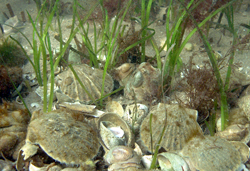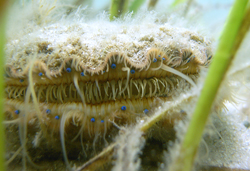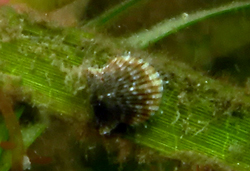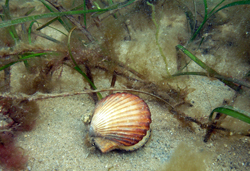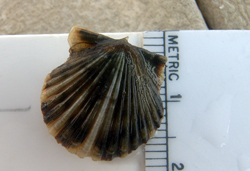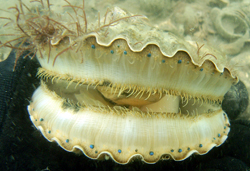 |
 |
||
Eelgrass and Bay Scallops |
||
|
The story of the Long Island bay scallop Argopecten irradians can't be told without mention of eelgrass Zostera marina, as the two populations share a history. Not surprisingly, when epidemics such as the ‘Wasting Disease’ of the early 1930’s and the brown tide blooms in the 1980’s occurred here on Long Island, resulting in large-scale die offs of eelgrass, bay scallop populations also plunged. "In 1982, the harvest of 500,000 lbs of bay scallops from the Peconic Estuary accounted for 28% of all U.S. commercial landings and had a dockside value of $1.8 million. After the appearance of the Brown Tide in 1985, the bay scallop population was virtually eliminated " (Peconic Estuary Program). Through restoration efforts, Cornell Cooperative Extension is working diligently to bring both of these populations back to pre-brown tide levels. Arguably, the most important role eelgrass plays in the life history of the bay scallop is the structure and protection it provides during its post-larval phase. Although other substrates and structures (including stones, shells and algae) can be used as attachment sites for "spat" or settled scallops, eelgrass has long been documented as their preferred habitat (Gustell 1930; Thayer and Stewart 1974). Juvenile bay scallops use byssal threads to attach themselves onto elevated portions of eelgrass blades, staying out of reach from crabs, whelks, and other benthic (sea floor) predators. The scallop spat that attach to the upper canopy of eelgrass (20-35 cm above bottom) have a significantly greater chance of surviving compared to those at the base of the eelgrass shoots or on unvegetated bottom. Also, there is a direct relationship between eelgrass density and scallop survival (Pohle et al. 1991), which means that the more dense the eelgrass, the higher the chances of the scallop surviving. Adult scallops are also protected by eelgrass. For example, large, above-water predators like sea gulls have a hard time pinpointing an adult scallop within an eelgrass meadow opposed to one on a sandy bottom. The presence of a continuous eelgrass meadow can also help prevent adult scallops from being washed up on shore during a storm event. As with terrestrial biologists, marine scientists often consider habitat restoration before attempting to restore a declining species, as habitat loss is often the underlying cause of the decline. Our eelgrass program is taking this approach with some of our restoration projects, including projects in the South Shore Estuary and in Huntington Harbor. Together with the CCE Aquaculture Program, these projects involve planting eelgrass in the early phases and then seeding scallops into these restored meadows in later phases (learn more...). To learn more about scallop biology and ecology as well as the Cornell Cooperative Extension Bay Scallop Restoration Project, see our Spring 2008 issue of our SEAGRASS.LI newsletter. An excellent manuscript was recently published addressing the history of eelgrass in the Northeast Atlantic and the link between bay scallops and eelgrass. It is an great resource for managers, scientists and the public alike can be found at the following National Marine Fisheries Service webpage: http://spo.nmfs.noaa.gov/mfr713/mfr7134.pdf. More scholarly articles on bay scallops can be found on the following page as part of a continuum on the bay scallop: http://spo.nwr.noaa.gov/mcontent.htm. See issue 2009, 71(3) as well as 2008 70(3-4). Next: Eelgrass and Shellfish Gallery of Eelgrass Fauna |
|
References: Gustell, J. 1930. "Natural history of the bay scallop." US Bureau of Fisheries Bulletin 46: 569-632 Eckman, J. E. 1987. The role of hydrodynamics in recruitment, growth, and survival of Argopecten irradians (L.) and Anomia simplex (D'Orbigny) within eelgrass meadows. J. exp. mar. Biol. Ecol. 106. 165-191 Fonseca, Mark S. and Amy V. Uhrin. 2009. The Status of Eelgrass, Zostera marina, as Bay Scallop Habitat: Peterson, C.H., H.C. Summerson, and P.B. Duncan. 1984. The influence of seagrass cover on population structure and individual growth rate of a suspension feeding bivalve, Mercenaria mercenaria. J. Mar. Res. 42: 123-138. Pohle, D.G., Bricelj, V.M., and Garcia-Esquivel, Z. 1991. The eelgrass canopy: an above-bottom refuge from benthic predators for juvenile bay scallops Argopecten irradians. Mar. Ecol. Prog. Ser. 74: 47-59. Thayer, G. W., and H. H. Stuart. 1974. The bay scallop makes its bed of seagrass. Mar. Fish. Rev. 36(7):27-30. |
||
HOME ~ CONTACT US ~ ABOUT OUR PROGRAM ~ CCE SUFFOLK COUNTY HOME
© 2017 www.SeagrassLI.org / Cornell Cooperative Extension Marine Program
